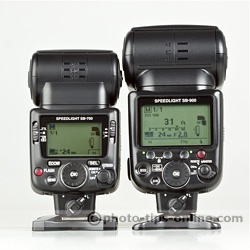Update: In-depth Nikon SB-700 vs. SB-900 comparision
The purpose of this article is to compare overheating protection (thermal cut-out) features of Nikon Speedlight SB-700 and Nikon Speedlight SB-900. Both flashes are capable of halting the operation in cases when the internal temperature reaches the levels that can cause damage. So, the idea is to see what it takes to make the thermal cut-out to kick in. For in-depth comparison of the two flashes please refer to Nikon Speedlight SB-700 vs. Nikon Speedlight SB-900 article.
 |
The main reason for flash overheating is the rapid firing. If you don't give your flash enough time between the bursts, it can overheat and break. The actual number of fires you can get out of your flash before it reaches dangerous temperature levels depends on other factors, as well, such as
We decided to take a simple approach and set the flashes to manual mode and full power. Flash zoom was at 35mm (the value at which Nikon flashes are rated in terms of the Guide Number). The flashes were fired by their test buttons repeatedly pushed as soon as the ready light came on.
Since Speedlight SB-700 is significantly less powerful than SB-900, it recycles faster and, therefore, the intervals between the test firings were shorter.
For each test, we used freshly charged set of Powerex batteries. Both Nikon SB-700 and Nikon SB-900 were not in use for several hours prior to the testing. The room temperature was about 60 degrees Fahrenheit (about 16 Celsius).
The tests were repeated a few times, and the results were fairly consistent with some variance.
The following video gives you an idea about how we performed the testing.
SB-900 could fire at full power about 20 times before the temperature indicator jumped to the middle position. In about 10 pops, the indicator jumped again to the 3/4 mark on the scale. At around 35 bursts, Nikon SB-900 stopped operating indicating the overheating. Please note, the batteries were very hot at the end of the test, which might have contributed to the increase of the temperature.
It took just a few minutes for the flash gun to become operational again. (Even though the temperature indicator was still showing a high level of temperature (3/4), the flash wasn't locked anymore.)
Just for the sake of the experiment, we decided to try an extreme zoom value of 200mm for another test run, and it turned out that the flash was able to give about 80 full power fires at that zoom level. Our guess is that temperature increase could be attributed to the heating of the front reflector due to the bulb being closer to it at wider zoom positions. In any case, the difference in the number of flashes fired is quite significant and worth mentioning.
SB-700 also showed variance in the number of bursts depending on the flash zoom value. At 35mm, however, it turned out to be less prone to overheating compared to its big brother. The half-way mark was reached after 50 fires, and it took almost 90 flash bursts to get the indicator to the 3/4 level, at which the flash gun roughly doubled its recycling time to give itself time to cool off. (We replaced the batteries to make sure that recycling time change was not caused by the battery drain.) So, after about 120 pops, we stopped the test not being able to put the flash into the state of overheating.
Nikon Speedlight SB-700 demonstrated better resistance to overheating despite the fact that it was fired at shorter time intervals. It could be because Nikon has improved its technology since the release of Speedlight SB-900, but it also could be merely because the lower output of SB-700 caused less problems. SB-900 would probably deliver a similar number of pops at the level equivalent to the full power of SB-700. The obvious difference in technology, however, is that Speedlight SB-700 flash gun automatically forces longer recycling times when the temperature reaches high levels, whereas SB-900 fires at the same rate until it shuts down due to overheating.
Finally, a useful thing to remember is that both Nikon Speedlights tend to overheat faster at wider flash zoom positions.